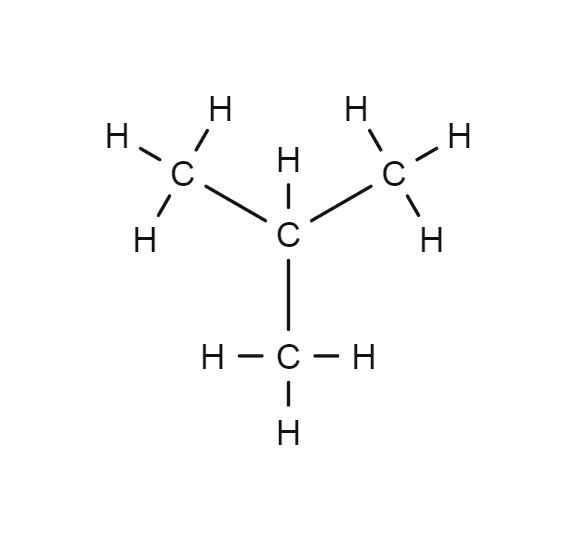
Isobutane
- C4H10
- CAS Number 75-28-5
- UN1969 (gas)
Click & drag to move the 3D molecule
Liquid / Gas Volumes
Calculate the volume or mass of a quantity of gas or liquid
Liquid Phase
At boiling point at 1.013 bar
Gas Phase
In standard conditions (1.013 bar, 15°C)
Physical Properties
Molecule phase diagram showing the transition phases between solid, liquid and gas as a function of temperature and pressure
-
- Molar mass 58.122 g/mol
- Content in dry air /
-
Critical Point
- Temperature 134.65 °C
- Pressure 36.4 bar
- Density 224.41 kg/m³
-
Triple Point
- Temperature -159.42 °C
- Pressure 1.206E-7 bar
Pressure 1.013 bar
| Latent heat of fusion (at melting point) | 78.112 kJ/kg |
| Melting point | - 159.61 °C |
Pressure 1.013 bar
| Boiling point | - 11.75 °C |
| Latent heat of vaporization (at boiling point) | 365.101 kJ/kg |
| Liquid density (at boiling point) | 593.821 kg/m3 |
| Compressibility factor Z | 9.6446E-1 |
| Cp/Cv ratio γ | 1.1185 |
| Gas density (at boiling point) | 2.826 kg/m3 |
| Gas density | 2.688 kg/m3 |
| Gas/(liquid at boiling point) equivalent | 220.92 vol/vol |
| Heat capacity Cp | 1.5902 kJ/(kg.K) |
| Heat capacity Cv | 1.4218 kJ/(kg.K) |
| Specific volume | 3.72E-1 m3/kg |
| Thermal conductivity | 14.343 mW/(m.K) |
| Vapor pressure | 1.577 bar |
| Viscosity | 6.8759E-5 Po |
| Compressibility factor Z | 9.7035E-1 |
| Cp/Cv ratio γ | 1.11 |
| Gas density | 2.5326 kg/m3 |
| Gas/(liquid at boiling point) equivalent | 234.47 vol/vol |
| Heat capacity Cp | 1.6503 kJ/(kg.K) |
| Heat capacity Cv | 1.4867 kJ/(kg.K) |
| Solubility in water | 2.333E-5 mol/mol |
| Specific volume | 3.949E-1 m3/kg |
| Thermal conductivity | 15.85 mW/(m.K) |
| Vapor pressure | 2.598 bar |
| Viscosity | 7.2505E-5 Po |
| Compressibility factor Z | 9.7354E-1 |
| Cp/Cv ratio γ | 1.1052 |
| Gas density | 2.4397 kg/m3 |
| Gas/(liquid at boiling point) equivalent | 243.4 vol/vol |
| Heat capacity Cp | 1.6923 kJ/(kg.K) |
| Heat capacity Cv | 1.5312 kJ/(kg.K) |
| Solubility in water | 4.659E-5 mol/mol |
| Specific volume | 4.099E-1 m3/kg |
| Thermal conductivity | 16.887 mW/(m.K) |
| Vapor pressure | 3.512 bar |
| Viscosity | 7.4978E-5 Po |
Applications
Examples of uses of this molecule in Industry and Healthcare

Laboratories & Research Centers
In mixture with argon, isobutane is used in Geiger counter and for the detector in X ray fluorescence as quentching gas. Isobutane is also used as reagent gas in chemical ionization mass spectrometry. In mixture with other hydrocarbons, isobutane is used as reference point in calorimetric measurements for the measurement of LHV of hydrocarbons. Isobutane is used in calibration gas mixtures for petrochemical industry, environmental emission monitoring, industrial hygiene monitors and trace impurity analyzers.

Other
Isobutane is used as a propellant, a solvent or a refrigerant.
Safety & Compatibility
Autoignition Temperature, Flammability Limits & Flash Point
Europe (according to EN1839 for Limits and EN 14522 for autoignition temperature)
| Autoignition temperature (Chemsafe) | 460 °C |
| Lower flammability limit (IEC 80079-20-1) | 1.5 vol% |
| Upper flammability limit (IEC 80079-20-1) | 9.4 vol% |
US (according to ASTM E681 for Limits and ASTM E659 for autoignition temperature)
| Autoignition temperature (NFPA 325) | 460 °C |
| Lower flammability limit (NFPA 325) | 1.8 vol% |
| Upper flammability limit (NFPA 325) | 8.4 vol% |
Metals
| Aluminium | Satisfactory |
| Brass | Satisfactory |
| Monel | No data |
| Copper | No data |
| Ferritic Steel | Satisfactory |
| Stainless steel | Satisfactory |
| Zinc | No data |
| Titanium | No data |
Plastics
| Polytetrafluoroethylene | Satisfactory |
| Polychlorotrifluoroethylene | Satisfactory |
| Polyvinylidene fluoride | Satisfactory |
| Polyvinyl chloride | Satisfactory |
| Ethylene tetrafluoroethylene | No data |
| Polycarbonate | No data |
| Polyamide | Satisfactory |
| Polypropylene | Satisfactory |
Elastomers
| Butyl (isobutene- isoprene) rubber |
significant swelling
Not recommended
|
| Nitrile rubber | Satisfactory |
| Chloroprene | Satisfactory |
| Chlorofluorocarbons | No data |
| Silicone |
significant swelling and modification of the properties of the material
Not recommended
|
| Perfluoroelastomers | Satisfactory |
| Fluoroelastomers | Satisfactory |
| Neoprene | No data |
| Polyurethane | Satisfactory |
| Ethylene-Propylene |
significant swelling and modification of the properties of the material
Not recommended
|
Lubricants
| Hydrocarbon based lubricant |
significant loss of mass
Not recommended
|
| Fluorocarbon based lubricant | Satisfactory |